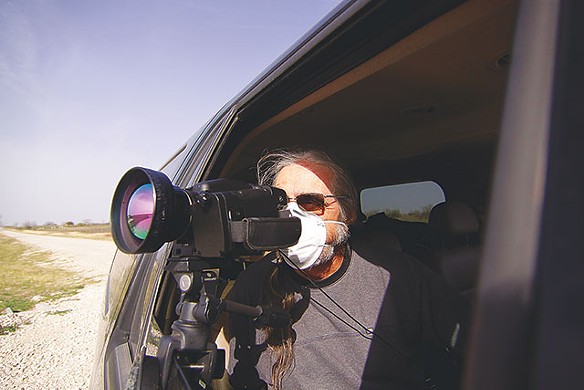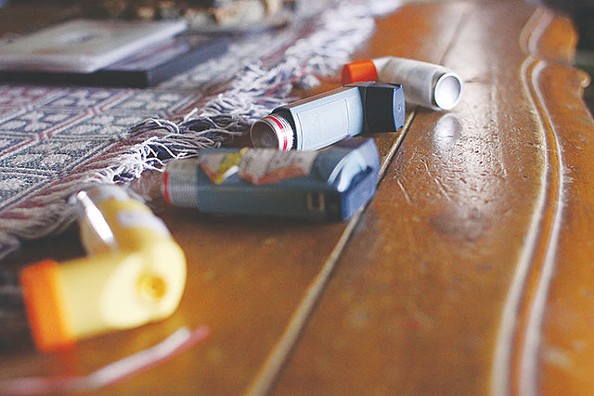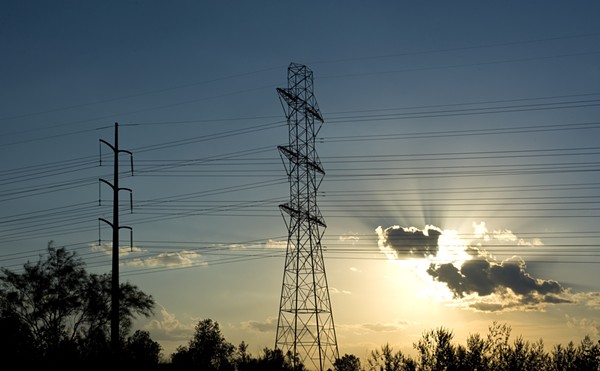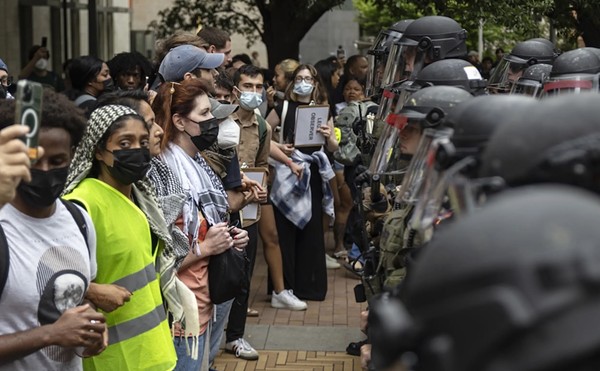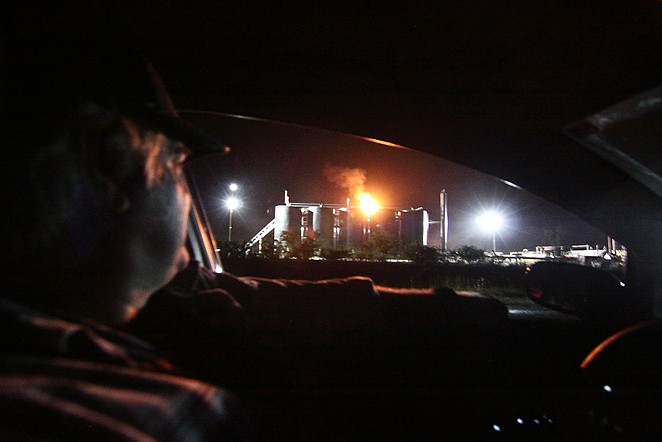
(See video of industrial flares surrounding the Cernys' home)
Off-duty San Antonio cops directed a thick swarm of traffic outside the Panna Maria community center in sleepy Karnes County one evening last December. Blue-shirted Marathon Oil representatives beamed, greeting more than 1,000 local landowners who gathered to talk oil, gas, and riches.
But from the moment they walked through the doors, Myra and Mike Cerny began to curse and mutter under their breath. They rolled their eyes at the Marathon freebies, like a water bottle emblazoned with the company logo, and leafed through handouts cheering the oil and gas development that now encircles their rural South Texas home.
Later, while chatting with Marathon representatives, I heard Mike across the room raising his deep, gruff voice.
“I am right in the middle of this stuff,” he told a Marathon worker. “I get three or four migraines a day now. … I never had migraines before in my life.” The headaches grew so persistent in recent months, Mike told the worker, that he shelled out $2,000 for a CT scan. About a year ago, to their surprise, the Cernys became a family of asthmatics, regularly sucking down albuterol inhalers just to breathe. Myra and Mike began to spot mysterious rashes on their arms and legs. Their teenage son suffered unexplained, gushing nosebleeds.
When I found Kirk Spilman, Marathon’s asset manager for the region, he talked me through the company’s commitment to corporate responsibility: how Marathon recently paid to boost law enforcement patrols in the area (an attempt to make the roads safer) and how that evening the company announced a $25,000 donation to local education efforts.
Eventually he got around to the Cernys’ troubles.
“Well, you have to understand their house is very close to the road,” Spilman remarked, before saying Marathon reps would look into the complaints.
In fact, they already had.
The Cernys contacted state environmental regulators nearly five months before Marathon’s community meeting, complaining of “odors described as sulfur and petroleum-like,” according to Texas Commission on Environmental Quality records. The Cernys worried the air around their house was being fouled by flares from storage sites leaving trails of black smoke. A TCEQ investigation would eventually show that at a nearby Marathon site, emissions of benzene, a known carcinogen, and other irritants far surpassed permitted levels.
In December, though, the Cernys weren’t aware of any of this. They just knew they felt sick, while Marathon officials at the meeting insisted they didn’t know of any problems. When the Cernys pressed, complaining about a flare roughly a mile from them that continued to spew smoke, Marathon reps denied the site even belonged to the company. “I just took a picture of the sign. It says Marathon,” Myra groused.
She was telling the truth, she pointed out the sign to me earlier in the day as we drove around the area.
The Cernys grew more agitated as Marathon reps nodded their heads, dutifully expressing their concern.
“Just follow the smoke, man,” Mike sighed. “Follow the smell. You’ll see what I’m talking about. You’ll see where we live.”
*****
As you drive into Karnes County at night, the sky begins to glow a bright, flickering orange with industrial flares, sign of the shale gas revolution beneath the South Texas dirt.
Many in the industry call the Eagle Ford Shale, a vast oil- and gas-rich geological formation stretching some 400 miles, the crown jewel of U.S. shale plays. Oil and gas companies use a drilling method called hydraulic fracturing, or fracking, in which they pump millions of gallons of water — mixed with sand and some 500 chemicals — thousands of feet below ground to crack the shale and release the goods.
Mike and Myra Cerny moved from the San Antonio suburbs to Karnes County nine years ago wanting a calm country life. Over the past two years, the trappings of oil and gas development have encroached on their small rural home. Drilling for wells in a field across the road from their house shook their walls so hard the ceilings cracked; more wells are now being drilled behind them. Big rigs speed down their rural farm-to-market road at all times of the day and night. Pallets flying off the backs of trucks have twice flattened their mailbox. Mike says he’s reluctant to buy another one.
“That would’ve killed me if I was standing in my yard,” he said.
What irritates the Cernys most, though, is the smell wafting in from nearby facilities.
The activity won’t stop any time soon.
South Texas is now the focal point of Marathon’s business strategy. The day before its Karnes County meeting in December, Marathon executives announced the company would pump $1.9 billion into the Eagle Ford region this year alone, more than a third of its 2013 capital budget.
“Much of that is going to be here in Karnes County,” Spilman, Marathon’s regional asset manager, told me. “This is going to continue for the foreseeable future, quite honestly, because in our opinion this is the best place for our company to invest.”
This month, when the Eagle Ford Shale Consortium gathered at the Grand Hyatt downtown, Marathon CEO Clarence Cazalot called the Eagle Ford the most promising oil and gas find in North America, maybe even the world.
“The fact that I stand here and say that is really sort of amazing,” he said.
Fracking the Eagle Ford, Cazalot told the 800-plus crowd, will not only provide a cheap, steady domestic energy supply, but a greener one, weaning us off coal and cutting down on climate-destabilizing carbon emissions.
As Cazalot and others noted throughout the conference, the boom is green in more ways than one.
The tax windfall from fracking flooded Texas’ now $12 billion Rainy Day Fund, which many hope lawmakers will tap to help pay for our pitifully under-funded State Water Plan. University of Texas at San Antonio’s most recent assessment says that in 2011 alone, the boom generated more than $25 billion in revenue, supported nearly 50,000 full-time jobs, and padded local governments with more than $250 million.
Consortium speakers acknowledged that once-sleepy rural towns have seen unnerving increases in deadly car wrecks, that housing and infrastructure can’t keep up with boom, and that truck traffic has torn county roads to ribbons. But, the consensus went, these are all fixable problems.
At the conference government officials, business leaders, and academics largely sidestepped what environmentalists consider the dark side of the play, ignoring nagging concerns over water contamination, aquifer depletion, and air quality.
That wasn’t the case at last year’s gathering. Back then, Alamo Area Council of Governments natural resources director Peter Bella warned of how drilling in the Haynesville Shale, near the Texas-Louisiana border, made regional ozone levels spike. The message: If we don’t understand, catalogue, and attempt to lower emissions from drilling in the Eagle Ford, our regional air quality could suffer, possibly knocking San Antonio from its tenuous standing as the largest U.S. city still within Clean Air Act compliance.
Bella wasn’t invited back to speak at this year’s consortium. Last August, two Bexar County ozone monitors for the first time picked up readings that violated federal air standards.
Researchers increasingly contend that fracking may release sizable amounts of harmful contaminants into the air, like methane and volatile organic compounds (or VOCs) like benzene, contrary to the drilling industry’s (and, seemingly, Texas regulators’) belief that there is little, if any, public health threat caused by fracking-related air contamination.
Last year the Colorado School of Public Health published a study indicating higher risks for cancer and other health problems because of air quality near fracked wells. About a mile out from fracking sites, researchers found elevated levels of benzene and other chemicals that can irritate eyes and cause headaches, sore throats, or breathing difficulties.
A follow-up study, published earlier this year in the journal Human and Ecological Risk Assessment, found dozens of so-called non-methane hydrocarbons in the air near Colorado drilling sites, including some chemicals known to harm the brain and nervous system.
Other studies, such as one co-authored by Anthony Ingraffea, argue that one of the “green” benefits of natural gas, that it burns twice as “clean” as coal, may actually be hot air itself. In 2011, Ingraffea, a professor at Cornell University’s School of Civil and Environmental Engineering, and his colleagues published a study claiming the best (though admittedly incomplete) estimates indicate that shale gas may emit as much as 20 percent more greenhouse gases than coal throughout its lifecycle. Industry-backed groups have attempted to discredit the Cornell study, like the American Clean Skies Foundation, chaired by Chesapeake Energy CEO Aubrey McClendon, which funded a major MIT study that criticized the Cornell researchers and their findings.
*****
Depending on where you drill, wells in the Eagle Ford pump out a combination of oil, gas, or condensate. Companies can store and ship the gases for treatment. If the pipeline infrastructure isn’t there or if those “economically irrelevant” reserves aren’t worth the hassle, companies can get a permit from state regulators to burn, or “flare”, the gases.
It’s roughly a mile from Mike and Myra Cernys’ front door to Marathon’s Sugarhorn Central Facility, home to multiple crude oil, condensate, and wastewater tanks, as well as two flares.
TCEQ records show an inspector first investigated the Sugarhorn facility on August 15, 2012 to follow up on the Cernys’ complaints.
An inspector spotted emissions coming from the storage tanks using an infrared camera. TCEQ records note that during a 12-hour period, the facility emitted 42 pounds of benzene, over four times what they permitted for that specific site. Hydrogen sulfide, a natural gas that can cause serious injury when inhaled even at minimal concentrations, leaked from the facility at over 100 times the permitted amount. Nearly 3,000 pounds of methane went into the air, records show.
When the TCEQ returned on September 5, emissions at the site still exceeded permitted levels. It wasn’t until October 24, records indicate, that regulators sat down with company officials to discuss “ongoing issues with Marathon’s facilities located in Karnes County.” When a TCEQ investigator returned on December 18, infrared video still showed emissions spewing from the facility’s storage tanks.
While TCEQ mandates companies report such “emissions events” within 24 hours, Marathon didn’t report the August and September incidents until December 20, well after two TCEQ investigations and a company meeting with regulators.
“It’s disconcerting to say the least,” said Wilma Subra, a Louisiana-based environmental scientist and MacArthur Genius Grant recipient who reviewed the TCEQ records.
Subra was troubled that when Marathon finally reported the problems — at TCEQ’s prodding — the company only did so as two isolated 12-hour events. “It’s hard to believe this was only happening the two days that TCEQ just happened to go out and investigate,” Subra said.
“For some of these compounds, it’s a huge quantity that got reported,” Subra insisted. For the August incident, benzene was at levels you’d expect to find near an oil refinery, she said.
“When, say, an oil refinery releases more than 10 pounds of benzene within that period, it’s a big deal,” Subra said. “Here we had 42 pounds of benzene released. It’s enormous.”
Prolonged exposure to benzene, Subra says, is known to cause leukemia and blood cell damage. In addition, TCEQ reports from the facility showed elevated levels of toluene, ethyl benzene, and xylene, compounds that may cause liver and kidney damage over long exposure periods, Subra says. In the short-term, “you’d expect to see nose, throat, eye and skin irritation,” Subra said.
After meeting with the Cernys this month to hear about their health complaints, Subra said, “What they’re reporting are exactly the health impacts you’d expect to see with these chemicals. … It correlates exactly.”
*****
Industry largely derides Sharon Wilson as an anti-fracking crackpot.
In 1996 Wilson left Fort Worth for some 40 acres she bought in rural Wise County. Soon afterward, wildcatter George Mitchell pioneered fracking as we know it today, and his Mitchell Energy & Development moved in next door to Wilson to frack the surrounding Barnett Shale. Within a few years, drilling rigs had sprouted up all around her, and Wilson grew weary of the waste dumping, the generators, and the foul air.
That’s when Wilson started her widely-followed fracking blog, Bluedaze, chronicling the dark side of life in oil and gas plays, posting page after page of disaster stories, toxic waste photos, and tales from sick families.
Myra and Mike Cerny complained to Marathon for months before finding Wilson. Last spring, the Cernys were still in talks with Marathon over a buy-out, hoping to leave the area. When Marathon reneged on the offer, Myra took to the internet searching for people like her. She soon landed on Wilson’s blog.
“The emails she sent me were just so sad,” Wilson said. “I knew they were miserable.”
This month, Wilson, Wilma Subra, and other activists toured Karnes County with an infrared camera, looking for fugitive oil and gas emissions.
At nearly every facility, including the one TCEQ investigated last year, contaminants were seen boiling out of flares and storage tanks.
“We’ve done this all over the Barnett Shale,” said Calvin Tillman, founder of North Texas-based air monitoring non-profit ShaleTest, looking at an infrared video feed on his laptop. “We’ve found small leaks, but the ones that are really just massive and bellowing, those are few and far between,” he said.
“Down here, nearly every single one we’ve filmed shows massive leaks. … It looks like the wild west down here.”
It’s still an open question whether significant leaks, like the kind happening near the Cernys, are anomalous or the norm industry-wide.
While industry estimates methane leakage rates of about 1.6 percent, recent research from the National Oceanic Atmospheric Administration and the University of Colorado at Boulder indicate the number could be as high as 9 percent. Finding the true number is critical. One study by scientists at Princeton University and the Environmental Defense Fund suggests that shifting from coal to natural gas will only reap climate benefits as long as methane leakage stays below 3.2 percent.
The EDF last year joined with University of Texas at Austin and nine major gas producers, like Chevron and ExxonMobil, to catalogue methane emission rates at shale gas wells across the country. David Allen, who led the fieldwork and data analysis for UT, said results have been submitted to a scientific journal and should be published within the next two months.
*****
None of the Cernys had inhalers until about a year ago. On a recent visit, Mike counted four lying around the house that he, Myra, and their teenage son regularly use.
“I mean, just sitting there looking at those, that’s fucking sad,” he told me.
“It’s now where our sinuses burn, our eyes burn so bad you have to rinse them out in the middle of the night,” Myra said. “The smell gets so heavy outside you feel like you have to vomit.” Family members will no longer visit them because of the noxious stink.
Myra and Mike left Marathon’s community meeting last December nonplussed. They’d expected a public question and answer period; there wasn’t one. They expected Marathon reps to take their concerns seriously; Marathon workers instead argued whether the nearby storage sites were even theirs.
A Marathon worker asked the Cernys whether they were getting their royalties. At one point the Cernys got one payment of about $1,700. This year, those royalty payments dipped down to a couple hundred dollars. The Cernys are told they might soon receive as much as $7,000.
“Honestly, I could give a flip about our royalties,” Myra told a Marathon worker. “We want our health back. We want our air back.”
Before leaving, Myra pulled out a stack of handouts on fracking emisions and their potential health impact. “Could you please get her to go outside to pass out those things?” a visibly uncomfortable Marathon worker asked Mike.
He responded, “Shit, you try.”

